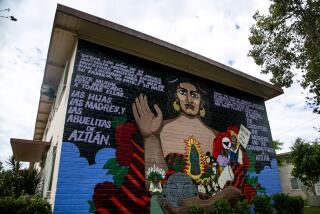Carving Out a New Future
- Share via
Born of rough backgrounds and trouble, the benches are solid, smooth pine. Carved from remnants of a convent, they are Mission style with a hint of Mexican colonial, suitable for gardens or indoor decor.
Buyers would probably prefer the benches in their homes to the people who built them.
Had they not found a nun and an architect with faith, the Benchmakers of Taller San Jose might now be costing taxpayers the usual 20 grand apiece for annual prison upkeep.
Instead, they are building a business and, they hope, a future.
Cesar Ornelas was a gangbanger whose number was up: A rival gang was stalking him. To get to his home in Anaheim, he would creep down his alley or jump fences yard after yard. “I was the next one, pretty much, on the list. They would roam around my neighborhood at night looking for me,” says Ornelas, 21.
When he eventually emerged from hiding it was to attend Taller San Jose, or Workshop of St. Joseph. His mother and sister had brought him a flier on its classes for high school equivalency diplomas.
Sister Eileen McNerney recalls Ornelas’ first day at the Taller building in Santa Ana more than a year ago. “He was physically and mentally disintegrating,” she says. “He didn’t speak for the first three months he was here.”
With each bench that Ornelas worked on, she says, his silence slowly lifted. Once he thought dishwashing was the best job he could get. Now he dreams of construction or carpentry. “Back then I didn’t know I could do better,” Ornelas says. “This has opened my eyes. I see I’m somebody. I could be somebody.”
*
Every bench has unique decorative detail and is signed and accompanied by a photo and bio of its maker. Prices range from $450 to $650. The buyer selects the bench style, size and finish (walnut stain or painted). All are hand-finished and made with wood joinery.
The wood comes from the salvaged doors and shutters of the renovated motherhouse for the Sisters of St. Joseph of Orange, the order behind the program. Bench-making is part of a larger learning center run on an annual budget of $300,000 by a staff of eight, half of them nuns.
About 100 Latinos, 18 to 25 years old, come to earn their diplomas and gain computer and job skills. Nine work as bench-making apprentices.
“I do all the arms here and the cutting,” says Jose Pajares, 20, as he runs chunks of wood through a table saw. “Each of us is good at something. Cesar does all the staining, and he seems to be good at that. I seem to be good at cutting. Raul does all the sanding.”
Across the sawdust-sprinkled room stands master carpenter Jose Gomez, 37, a Taller staffer who hopes to prepare these young people for better jobs. He instructs them in the basics until they get them right. Then the apprentices advance to new challenges like finishing and decorative work.
McNerney says most of Taller’s students can’t afford to be out of the work force for more than a year, so part-time pay for bench makers allows them to attend Taller’s classes at the same time.
“We want to expose them to their own arts and styles of their culture, but also American culture and work ethics,” she says. “The importance of arriving on time, performing jobs in an assigned amount of time, working in teams, following through.”
*
The Taller concept seems so promising, one might wonder why it sprouted only about 18 months ago. But then, not every program has patron saints.
The Sisters of St. Joseph nuns who had moved to Santa Ana in recent years saw young people adrift, jobless and uneducated, with nothing but a dead end in sight. Could they offer a detour?
McNerney thought so. She made a plea to the order to form a center where young Latinas and Latinos could earn their high school diplomas and learn some job skills. The sisters committed $200,000, about half of what McNerney figured she needed. But if a building were donated, her fund-raising work might be cut in half.
About that time, mutual friends in St. Joseph’s parish introduced the nun to an architect, Dominic Walsh, who had a reputation for being good with neighborhood teens. In December 1993, the two teamed up. Less than two years later, Taller opened in a building leased for $800 a month from the city of Santa Ana. The program’s first participants paid their “tuition” by rehabilitating the rundown 70-year-old structure.
“We decorated the building with art from their heritage--Mexican, Native American--because we want them to feel proud of that too,” McNerney says.
The workshop is in a gang-neutral neighborhood, so nobody has to tread through turf of their former enemies. It is, students say, an island of safety.
Pajares never told his gang he was bailing, “because that is not a wise choice. You get out, but you get out almost dead. They jump you out. They all jump you and beat you. So I just tell them I have to work all day, then I get home and want to play with my kids.”
They still accuse him of “ranking out,” but so be it. “I feel pretty good about myself. It feels pretty good to say that.”
More to Read
Sign up for Essential California
The most important California stories and recommendations in your inbox every morning.
You may occasionally receive promotional content from the Los Angeles Times.










